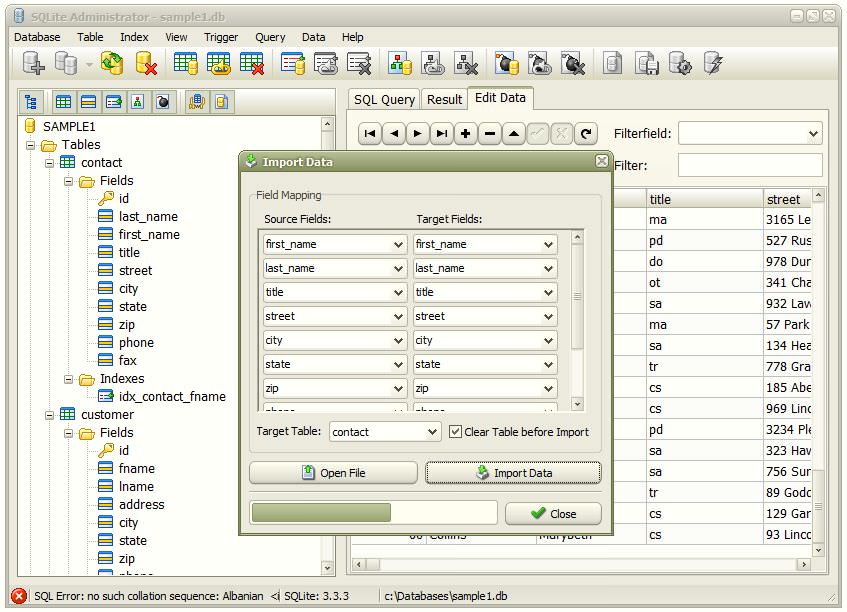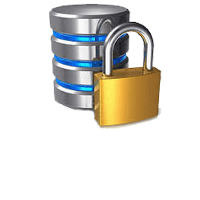
Sqlite file software#
This software is very similar to Microsoft Access and works with a variety of operating systems. Usage To make a SQLite file accessible to DuckDB, use the ATTACH command, for example with the bundled sakila.db file: CALL sqliteattach ( sakila. The data can be queried directly from the underlying SQLite tables, or read into DuckDB tables. This is not possible with SQLite, but you can use a freely-available tool such asĭB Browser for SQLite. The sqlitescanner extension allows DuckDB to directly read data from a SQLite database file. You may use WHONET's 'Data entry' module to view and edit the SQLite files by pressing 'View database.'ĭBASE files could be opened but not edited with Excel. This setting can be found by pressing 'Edit format' then 'New data file' in BacLink. You may wish to change the default 'File format' for BacLink's output files to SQLite.
Sqlite file update#
There is no requirement for you to update your existing dBASE files to SQLite, but you will notice faster analysis times if you do.You may use it to transform many files at once. This feature will transform your WHONET dBASE files into SQLite, while leaving the original data files unchanged.WHONET also has a convenient feature 'Update data files to SQLite' accessible from the 'Data entry' menu.In WHONET's data entry module or BacLink's 'File format' simply choose SQLite from the list of file types for your new data files. The below table gives examples of the performance improvement using WHONET SQLite data files using one year of data from a 700-bed hospital and over 70,000 samples. You can use any combination of the old dBASE and new SQLite files without issue, assuming you do not have one of the compatibility problems referenced above. Our new versions of WHONET support both the existing WHONET dBASE files, as well as the new WHONET SQLite files. SQLite is recommended for long-term data storage by the United States Library of Congress.Some computers have compatibility problems with dBASE files.More sophisticated capabilities, transaction support, indices, views, etc.Supports much larger data files (dBASE has a strict 2GB limit).More compact files (smaller file size) versus dBASE when storing the same information.Much simpler to use than MySQL, SQL Server, Oracle, etc., requiring no database server.Data are managed as individual files in exactly the same way that we use WHONET dBASE files, so your data management will remain the same as it has always been.Compatible with modern web browsers, which will be important for our future web version of WHONET.WHONET is currently only natively-compatible with Microsoft Windows,īut SQLite may allow emulation systems to function much better than with the dBASE structure on MacOS and Linux. Compatible with modern versions of Microsoft Windows, MacOS, and Linux.Modern database platform, described as "the most used database engine in the world".WHONET and BacLink are now ready to support a newer and more modernĭata structure called SQLite which offers many advantages over dBASE. Which has worked well for WHONET users for many years. SQLite.For the past twenty years, WHONET has relied on a simple but robust data file structure called dBASE (also known as DBF files),.For more formats based on SQLite, see Category:SQLite based file formats.

** enough to know that calling the developer will not help get rid
Sqlite file code#
** anybody smart enough to figure out the code is also likely smart So the temp files are still identified, but ** For this reason, the default name prefix is changed to be "sqlite" ** developers and call to wake them up at night and complain. ** Google search for "sqlite", find the telephone numbers of the ** started putting files with the "sqlite" name in the c:/temp folder. ** Mcafee started using SQLite in their anti-virus product and it ** : The default prefix used to be "sqlite_". SQLite creates temporary files that, by default, begin with the prefix etilqs_ and have no file extension.

Also, a shared-memory file is often used for a hash-table index of the write-ahead log, with a. The complete state of an SQLite database is usually contained in a single file on disk called the main database file.


This file is a separate file from the main database, using -wal at the end of the file extension so that it becomes. csv) at some point, switching ones storage medium to a SQLite database file and. Database access uses both files to get the latest changed version even if part of it is still in the "WAL" file. Assuming most of us have stored information in a text file (.txt. Some versions of SQLite use write-ahead logging to store new changes to the database before they are written to the main database file, allowing a rollback of the current set of changes before they are committed.


 0 kommentar(er)
0 kommentar(er)
